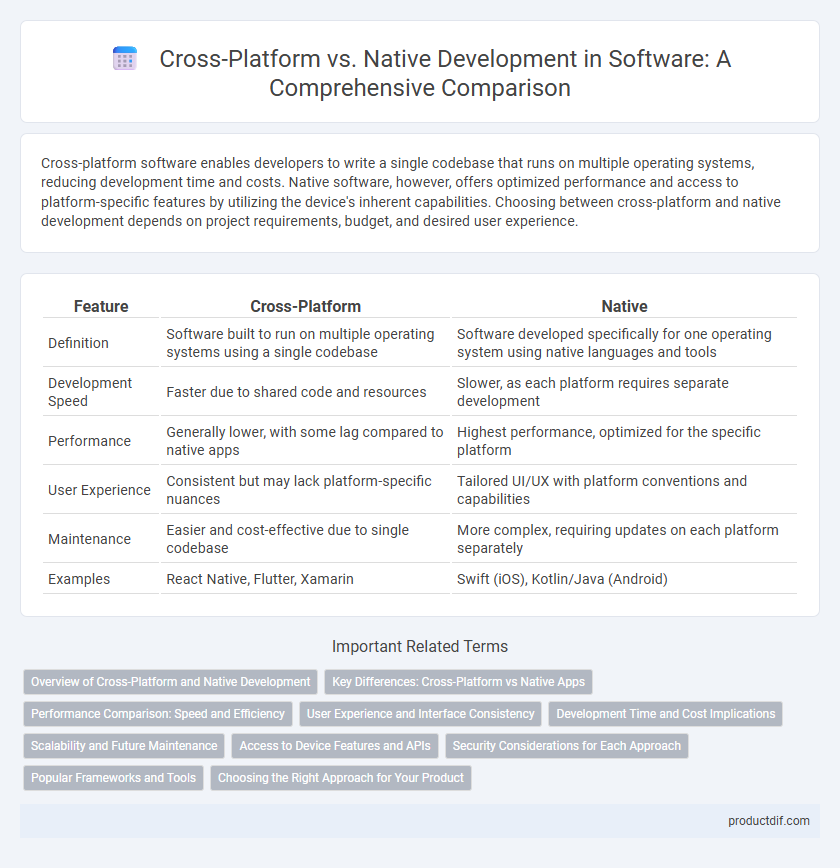Cross-platform software enables developers to write a single codebase that runs on multiple operating systems, reducing development time and costs. Native software, however, offers optimized performance and access to platform-specific features by utilizing the device's inherent capabilities. Choosing between cross-platform and native development depends on project requirements, budget, and desired user experience.
Table of Comparison
| Feature | Cross-Platform | Native |
|---|---|---|
| Definition | Software built to run on multiple operating systems using a single codebase | Software developed specifically for one operating system using native languages and tools |
| Development Speed | Faster due to shared code and resources | Slower, as each platform requires separate development |
| Performance | Generally lower, with some lag compared to native apps | Highest performance, optimized for the specific platform |
| User Experience | Consistent but may lack platform-specific nuances | Tailored UI/UX with platform conventions and capabilities |
| Maintenance | Easier and cost-effective due to single codebase | More complex, requiring updates on each platform separately |
| Examples | React Native, Flutter, Xamarin | Swift (iOS), Kotlin/Java (Android) |
Overview of Cross-Platform and Native Development
Cross-platform development enables building applications that run on multiple operating systems using a single codebase, enhancing development efficiency and reducing costs. Native development involves creating software specifically tailored for one platform, providing optimal performance and seamless integration with device features. Choosing between cross-platform and native approaches depends on project requirements such as user experience, budget, and time-to-market considerations.
Key Differences: Cross-Platform vs Native Apps
Cross-platform apps use a single codebase to run on multiple operating systems like iOS and Android, enabling faster development and reduced costs. Native apps are developed specifically for one platform using platform-specific languages like Swift for iOS or Kotlin for Android, resulting in better performance and seamless access to device features. The choice between cross-platform and native development impacts user experience, development timeline, and app maintenance complexity.
Performance Comparison: Speed and Efficiency
Native software development generally offers superior performance due to optimized code that directly interacts with the device's hardware and operating system, enabling faster execution and lower latency. Cross-platform frameworks often introduce abstraction layers that can result in increased processing overhead and reduced efficiency compared to native apps. However, advances in cross-platform technologies like Flutter and React Native are narrowing the performance gap while providing faster development cycles and consistent user experiences across multiple platforms.
User Experience and Interface Consistency
Native software development delivers superior user experience and interface consistency by leveraging platform-specific UI components and system capabilities, resulting in smoother performance and intuitive interactions tailored to each operating system. Cross-platform frameworks aim to achieve uniformity across multiple devices but often sacrifice responsiveness and native look-and-feel, potentially leading to inconsistent user interfaces and fragmented user experiences. Prioritizing native development enhances usability and design reliability, crucial for applications demanding high performance and seamless user engagement.
Development Time and Cost Implications
Native development often requires separate codebases for each platform, significantly increasing development time and costs due to duplicated efforts and platform-specific expertise. Cross-platform frameworks enable code reuse across multiple operating systems, reducing development hours and expenses, though sometimes at the cost of performance optimization and access to platform-specific features. Companies must weigh immediate cost savings against potential long-term maintenance and performance trade-offs when choosing between native and cross-platform development.
Scalability and Future Maintenance
Cross-platform development offers scalability by enabling apps to run on multiple operating systems with a single codebase, reducing development time and costs. Native development provides better future maintenance due to direct access to platform-specific features and optimized performance, ensuring easier updates and bug fixes. Choosing between the two depends on the project's requirements for scalability and long-term support capabilities.
Access to Device Features and APIs
Cross-platform development frameworks often provide standardized APIs that enable apps to access device features like cameras, GPS, and sensors across multiple operating systems, but may have limitations in performance or feature parity compared to native solutions. Native apps, built specifically for iOS or Android, have direct access to the full range of device-specific APIs and hardware capabilities, ensuring optimized performance and integration with the latest platform features. Developers prioritizing advanced device functionality and responsiveness typically prefer native development due to its superior access to platform-specific APIs and hardware features.
Security Considerations for Each Approach
Native applications offer enhanced security by leveraging platform-specific features such as biometric authentication, secure storage, and strict sandboxing enforced by iOS and Android operating systems. Cross-platform apps, while enabling code reuse across multiple OS environments, may introduce vulnerabilities due to shared codebases and potential reliance on third-party frameworks with inconsistent security updates. Security strategies for cross-platform development must emphasize rigorous code audits, frequent patches, and integration of native security APIs to mitigate risks inherent in multi-environment deployment.
Popular Frameworks and Tools
Popular cross-platform frameworks like React Native, Flutter, and Xamarin enable developers to write a single codebase that runs on both iOS and Android, significantly reducing development time and costs. Native development tools such as Swift and Kotlin provide optimized performance and deep integration with platform-specific features, making them ideal for apps requiring high responsiveness and advanced hardware access. Choosing between cross-platform and native depends on project requirements, with cross-platform favored for rapid deployment and native preferred for performance-intensive applications.
Choosing the Right Approach for Your Product
Choosing the right development approach depends on factors like target audience, performance requirements, and budget constraints. Cross-platform frameworks, such as React Native and Flutter, allow faster deployment across multiple operating systems with shared codebases, optimizing time and cost-efficiency. Native development delivers maximum performance and access to device-specific features, making it ideal for products demanding high responsiveness and advanced functionality.
Cross-platform vs Native Infographic

 productdif.com
productdif.com